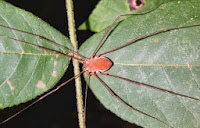No, this is not a weight program for hummingbirds, but a
quixotic attempt to see if I can detect what a “fattened up” hummingbird looks
like compared to their usual size. Its
fall, you see, and I have often read that they need to add a good 40% to their
weight before they attempt migration, at least migration over a body of water,
like some of them may do over the Gulf and so, I am looking for a chunkier than
normal looking bird.
Quixotic is the right word for this, for I have read that
they go from 3.25 grams to 6 grams prior to flying over the Gulf. Something tells me 2.75 grams doesn’t show up
as much as my 10 lb. gain since being in Texas does. Still, life is made up of little challenges
like these. Poor little things, they
weigh them again when they land and they are only at 2.5 grams. Hopefully some nice Mexican spiders are
waiting for them, lush nectar to wash it down with so they can regain what they
lost.
Here in TX we are host in the summer to the Black Chinned
Hummingbird, whom I haven’t seen in awhile.
Visitors to my feeder are definitely that, visitors. Red Throated Hummingbirds, first the males,
then the females, have been straggling through.
They stay a few days and perhaps are fattening up, indiscernibly, then
flying every southward.
So many of the small song birds and others fly by night; its cooler, fewer predators, but the hummingbirds travel solo, and by day,
supposedly, just over the treetops. They
do stay and dine awhile where they find nectar available and the only non-stop
push is the 500 mile flight over the Gulf.
Not that all of them go that route, at least not in the fall with the
threat of hurricanes being encoded somehow in their DNA. Instinct is what drives them on; the ones
born this summer aren’t following the crowd but just following the inner drive
to eat a lot and head south.
And whereas the larger migrating birds may cover a couple of
hundred miles a day, hummingbirds do about 23 miles a day. Clearly, those coming from Canada have to leave
early. I know on the Cape, by now, I
would probably be missing them. For that
matter, it has slowed down here in TX too, with most of them making the TX
coast by just about this time in Sept but not all.
And that is the key point.
Keep those feeders out, even after they appear to be gone, for the late
straggler, the last one hatched out of the nest etc. And they are faithful to return to where the
food is something they can count on. The
hummingbirds that stay with you all summer are the progeny of generations of
hummingbirds that have found your sugar water and flowers to be just
right. Even the migrants are said to
have their own favorite remembered stops along the way. Makes me think I should maybe hang my feeder
on a really high pole in fall so it can be seen from the “interstate”.
And if you happen to see any that have let another notch out
of their belt, let me know. You may have
keener eyes than I do for such a thing.




































